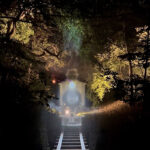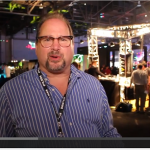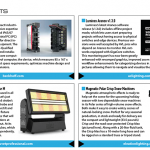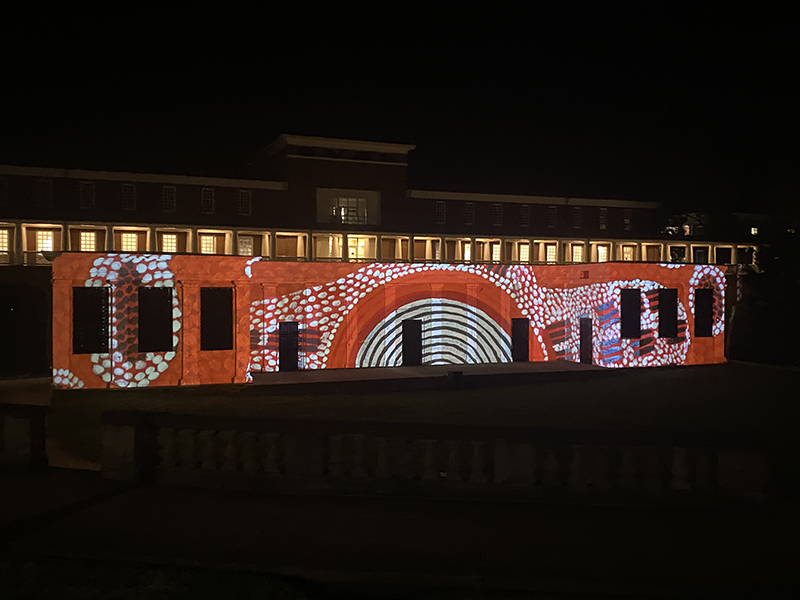
Setting a Tone for Renewal, and a Brighter Future Ahead
The University of Virginia’s Charlottesville campus is more than a place of study for its roughly 22,000 students. Located on the west side of this easy-going college town, UVA’s student body equals about half of Charlottesville’s population, making it the largest institution in the area. This means the iconic campus serves as a central meeting place for the area’s residents as well as students, providing music performances, sports, art exhibitions, lectures, learning opportunities, and special events.
So when the pandemic shut the campus down for more than a year, the entire area felt its absence in their lives. As vaccines became available in early 2021 and people began venturing onto campus again, university officials saw the need to do something extra to reunite the community at large.
The university wanted to inspire and entertain as many people as possible, with the goal of setting a tone of “renewal and a brighter future ahead,” according to a news release. Restrictions remained, however: Any special events would be free of charge, and they had to take place outdoors to allow for continued social distancing.
To achieve this tall order, the university turned to visual technology artist Jeff Dobrow, who is based in Charlottesville. Dobrow had met Jody Kielbasa, UVA vice provost for the arts, in discussions for the university’s bicentennial in 2019 (For more on Dobrow’s extensive background, go to zilog80.com).
“We were looking for ways to engage students in pop-up performances during the spring semester in ways that would be fun, uplifting, joyful, and of course, safe,” Kielbasa said, in an article describing the event on UVA’s website. “These have been difficult times for all of us in this community, and around the world, and one of the things we all were reminded of is just how important the arts are to our lives. Here was a great chance to allow us to come together to appreciate art safely in a communal setting.”
Dobrow, Kielbasa, and other senior staff members brainstormed ideas and came up with a series of projection mapping events, as part of a program called Brighter Together. They selected four buildings on campus — McIntire Amphitheater, Old Cabell Hall, the Rotunda, and the University Chapel — and tasked Dobrow with developing five programs of interactive artwork on a blistering 12-week schedule.
The only mandates from the university were that the programs run consecutively from March through May, and that they capture the spirit of spring, light, and moving forward. “We’re not looking to think too much here — just enjoy, like fireworks,” said Dobrow.
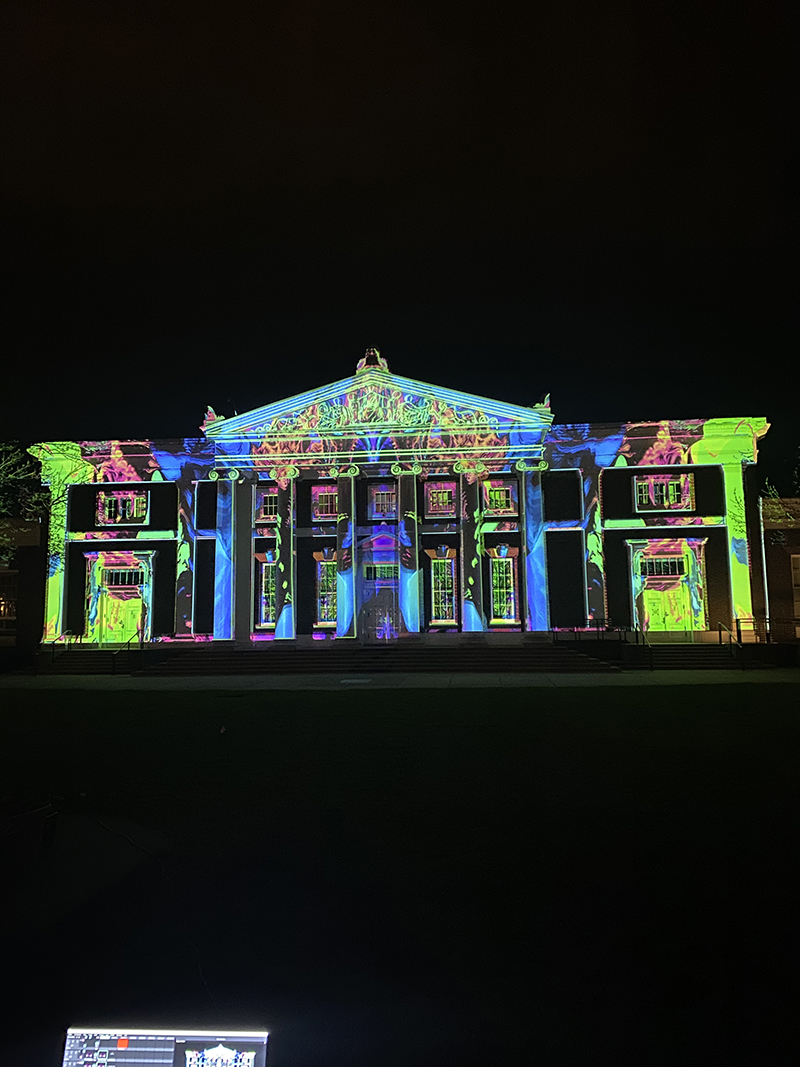
Hitting the Ground Running
The intricate process requires precision 3D mapping of each building, said Dobrow. “Sometimes there are blueprints available, but usually I’m taking a lot of photos, measuring the height of a brick and counting the number of rows. Once I have that model, I figure out the show site, where I want the people to be, and I figure out the template — the camera position and the actual building model. It’s like I’ve made a Jell-O mold, and now I’m going to paint on it. I set up and test, and as long as my building model is accurate, it will fit perfectly.”
In this case, however, the timeline created significant challenges. “I was doing a building every two weeks,” said Dobrow. “Normally, I would want at least a month for mapping. Each one requires me to scout it to take all the precise measurements, then create a 3D model, testing, animation and creative time, more testing, and setup. I worked 18/7 for three months on this project.”
All five programs featured a similar airiness and buoyant quality, said Dobrow, but each one presented something completely different from the others.
“The Rotunda featured growth — trees growing, a butterfly emerging from an ethereal cocoon,” he said. “The Chapel was a visual feast. I used Unity,” a real-time environment used to develop games, XR and other interactive applications, “to generate particles that led to golden tigers in a vast forest.”
For Old Cabell Hall, Dobrow created a largely graphic program, combining animated images pulsing to the music — at once floral, flowing, and geometric — that traced the building’s columns, roof line and entablature.
All three of these programs used the music of local duo Red Flower Lake. “Music drives every piece I do,” said Dobrow. “If you see a piece from me, the first thing I’ve done is find the right music — bass heavy, electronic music. Without it, I cannot do it — there’s nothing to be passionate about. Red Flower Lake came up with original pieces or paraphrased their pieces for the mapping. We worked back and forth to make it fit perfectly.”
At the McIntire Amphitheater, a partnership with the Kluge-Ruhe Aboriginal Art Collection, housed inside, resulted in an animated sampling of the work of contemporary Australian Aboriginal artists. Set to “A Shade Away” by National Indigenous Music Award winner Electric Fields, the constantly moving projections highlight this artistic culture’s extensive use of dots in creating fascinating images.
The showstopper, however, came in the final weekend of the production. Dobrow designed a second program against the backdrop of the Chapel, this time creating the illusion of the building’s façade shattering into thousands of prismatic pieces, immediately rebuilding itself and transforming into strings in rainbow colors. When the images became whole again, they revealed a parade of upraised arms with hands holding rolled diplomas, and a banner congratulating the graduates of 2020 and 2021.
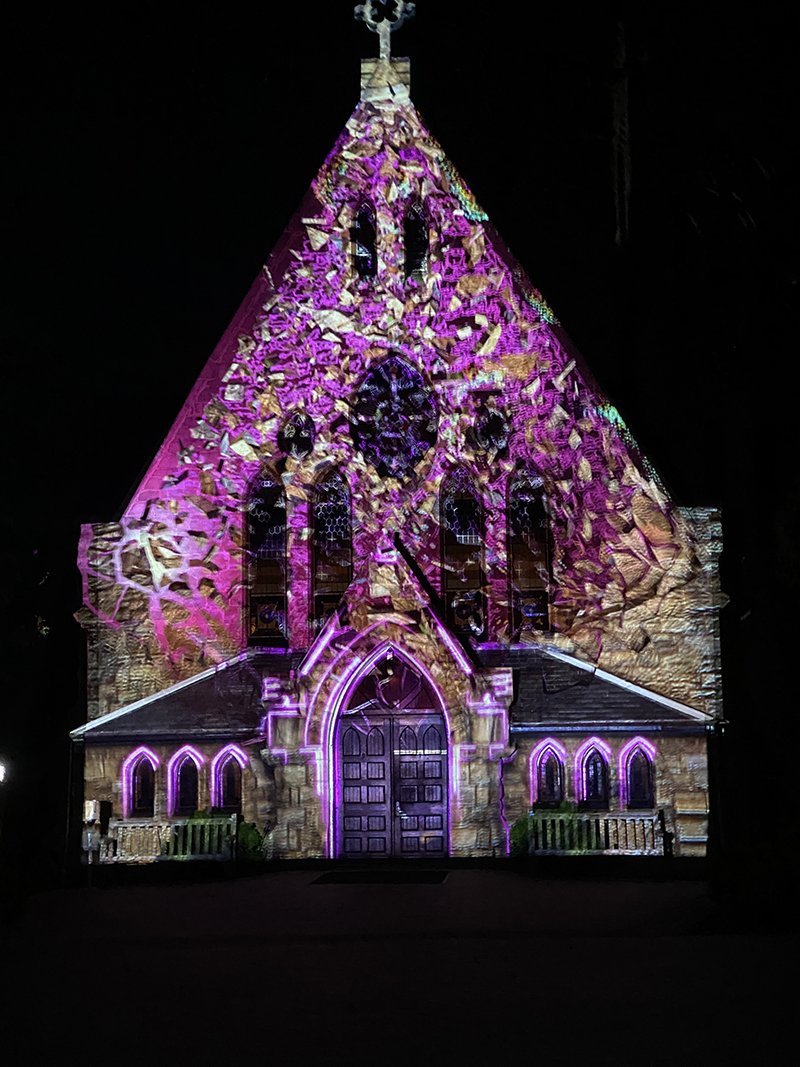
The Right Tech
Dobrow uses a range of tools to create the artwork, he said. “The content itself is a piece of motion design. It could just as well be a superhero in a movie or a logo tumbling; I am choosing to do this on a building. So, I use the industry standard tools: 3DS Max, Blender, and Synesthesia for live music visualization among many others. Unity is very powerful and relevant these days because it’s a real-time environment. And of course, the full Adobe suite, especially After Effects.”
To project the artwork, Dobrow chose three Epson Pro L1505UNL laser projectors, equipped with Epson’s Projector Professional Tool (EPPT) software. EPPT software simplifies the setup of multiple projectors in a single space, with easy access to geometric correction, edge blending, and other fine adjustments, and no fumbling with a complex remote control. For playback and content adjustments, he used Resolume projection mapping software, allowing him to manage the content while sending multiple high-resolution streams to the projectors.
“There’s not much in the way of units and gear that are remotely oriented towards mapping,” said Dobrow. “Most are for large-scale entertainment in huge auditoriums, so they are big and heavy and there’s a lot of features that you don’t need. Epson projectors are not ridiculously expensive — you are getting a tremendous value. They are lighter and more compact — there’s a lot of physical work and labor to map a building. Being able to do that more easily is very important.”
The color accuracy also impresses him, he noted. “When you do mapping like this, what you see on site can be completely different from what you see at home. With Epson, I don’t find myself thinking, ‘Ugh, it’s the building,’ because the color looks right — it’s really, really amazing. That is not always the case with other projectors.”
UVA launched Brighter Together in a low-key way with minimal publicity, having it simply appear on the first Friday night as students milled about campus. Shortly after the first show, however, word spread, and by Saturday night people began to gather. “Then the community turned out,” said Dobrow. “And it was the season of Brighter Together throughout the spring.”
Dobrow took advantage of the opportunity to introduce students to this kind of art. “Students who were not familiar with projection mapping wanted to learn more about it,” he said. “It was mind boggling, and I’ve made so many connections. Now I’m doing a workshop on projection mapping at Wilkes University in Pennsylvania. What I’m doing now, someone maybe gets inspired and discover a whole new world of art!”
To see video of all five shows, visit www.plsn.me/UVA. To learn more about Epson large-format projectors, visit www.plsn.me/Epson-Big.
